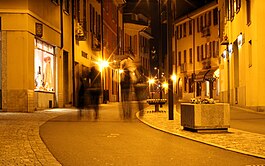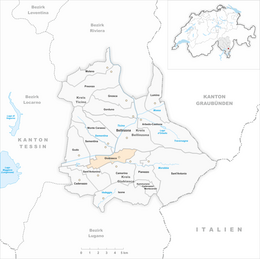Giubiasco
| Giubiasco | ||
|---|---|---|
 |
||
|
||
| Coordinates: 46°10′N 9°1′E / 46.167°N 9.017°ECoordinates: 46°10′N 9°1′E / 46.167°N 9.017°E | ||
| Country | Switzerland | |
| Canton | Ticino | |
| District | Bellinzona | |
| Government | ||
| • Mayor | Sindaco | |
| Area | ||
| • Total | 6.23 km2 (2.41 sq mi) | |
| Elevation | 242 m (794 ft) | |
| Population (Dec 2015) | ||
| • Total | 8,627 | |
| • Density | 1,400/km2 (3,600/sq mi) | |
| Postal code | 6512 | |
| SFOS number | 5005 | |
| Surrounded by | Bellinzona, Camorino, Gudo, Monte Carasso, Pianezzo, Sant'Antonino, Sementina | |
| Twin towns | Prilly (Switzerland) | |
| Website |
www SFSO statistics |
|
Giubiasco is a municipality in the district of Bellinzona in the canton of Ticino in Switzerland.
Due to its location at the center of numerous routes through the Alps, Giubiasco has been important since ancient times. The roads over the Monte Ceneri to the south, the Passo di San Jorio from the east, over the San Bernardino Pass and the Gotthard Pass from the north and the route along Lake Maggiore from the west all meet at Giubiasco.
The discovery of the great cemetery of Giubiasco in 1900, led to uncontrolled treasure hunting and the loss of many objects. It was not until 1905 that the Swiss National Museum organized an excavation, which made it possible to save a certain number of graves and document the discoveries scientifically. Further, limited archaeological digs were organized in 1958 and 1971 to explore the edges of the graveyard. A large part of the collection is kept in the National Museum in Zürich, while other items have been given to various foreign and Swiss museums. For example, the British Museum has an impressive collection of about 300 Iron Age artefacts from the site, which mostly include La Tène, copper alloy jewellery and pottery vessels. They were originally excavated from various graves in Giubiasco and were later donated to the BM by John Brunner and the Swiss National Museum. The latest discoveries are in the Conservation Office in Bellinzona.
The large necropolis, which was not far from the modern train station, has 565 graves. It is one of the rare examples of a site that was in continuous use for a particularly long period, stretching from the late Bronze Age (11th century BC) to the Roman period (2nd century AD). However, only the massive graveyard has been discovered, to date no associated settlement has been located. The cemetery has several different types of graves. The few Late Bronze Age graves are all cremation urn burials. The ashes of the deceased were buried in clay urns in simple trenches in the bare earth, the offerings are modest and consist almost exclusively of fragmented traditional ceramics.
...
Wikipedia



